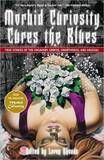 Scribner / October 2009
Scribner / October 2009
Reviewed by: Martel Sardina
For ten years, Loren Rhoads took readers of Morbid Curiosity magazine on a journey exploring true tales of the “unsavory, unwise, unorthodox and unusual.” Had I known of the magazine’s existence when it was being published, I surely would’ve been a fan. I learned of the magazine after its run, while discussing a story idea with a collegue at the World Horror Convention in Salt Lake City. My collegue’s advice was, “Get in touch with Loren Rhoads and see if she still has a copy of the essay about the guy who used to work for the Coast Guard.”
The essay in question, “The Jumper and The Crabs” by Kalifer Deil, is about a young Coast Guard recruit’s first look at death when charged with retrieving a “floater” from the bay near Sausalito, CA. Imagine for a moment, not only what the experience of seeing a dead body for the first time would be like, but also having to touch the body in an attempt to find clues that might identify the deceased. As the chef’s assistant, it wasn’t exactly the type of assignment he was expecting. But it was hardly the strangest thing that happened to him that day. In the process of retrieving the body, Deil and his boss, Van, also caught a bucket full of crabs. And as Deil soon learned, when someone asks “What’s cooking?” volunteering information about where dinner came from isn’t strictly necessary.
I was pleased to see that Diel’s story made the cut when Rhoads had to decide which of the over three hundred essays she originally published would be included in this anthology.
The anthology begins with a brief history of how Rhoads came to publish the magazine in the first place. Her choices are subcategorized in six sections: Childhood’s End: Growing Up Morbid, Far From Home: Morbid Curiosity on the Road, Gainful Employment: The Morbid Things People Do For Money, Curious Behavior: The Morbid Catchall Category, Medical Adventures: Morbid Medicine, and Beyond Death: Exploring Behind the Curtain. The essays range in tone from humorous to melancoly to frightening.
In the section Far From Home, Brian Thomas describes his experience of visiting Auschwitz. At one point in the tour, the guide showed Thomas a room containing four brick-walled booths in various states of construction. The one closest to him was a single layer of bricks forming a square outline on the floor. The second was knee high. The third was shoulder high. The final booth reached from floor to ceiling and had an 18 x 24-inch door at the bottom. These booths were some of the gas chambers used by the Nazis to exterminate the Jews. The guide invited those on the tour to step inside the chambers if they wished. A few stood in the knee high booth but none dared to try the others. Thomas lagged behind as the rest of the group proceded on the tour and decided to give the fully enclosed booth a try. While one can argue whether or not what happened to him once inside was the by product of his imagination or a supernatural encounter, Thomas renders the experience with vivid details. At times, he gives readers the sounds and smells bringing life to his tale only to show what the other side might have been like when he is deprived of certain sensory data while inside the chamber. By the end of the tour, Thomas is forever changed and readers should be as well.
In the Medical Adventures section, T.M. Gray recounts her experience as a victim of “Anesthesia Awareness.” This phenomena is a closely guarded secret in the medical community. No one wants to admit that there are times when anesthesia during surgery doesn’t work as it should. In Gray’s case, she was awake, aware, and in pain during the procedure being performed but was unable to move or communicate with the doctors to let them know that the anesthesia didn’t work. After the procedure was over and she regained her ability to communicate, she told the doctors of her experience. The doctors tried to convince her that either she was dreaming or she was crazy. Not only did she have to recover from the problem that she initially sought treatment for but also had to battle to get care for the post-traumatic stress that occurred as a result of being awake during the surgery.
Rhoads ends with her own essay, “The Mortician’s Gift,” and leaves readers to ponder her theory about how experiencing a little “real” horror can change your perspective on life and hopefully make you appreciate what you have.
Morbid Curiosity Cures The Blues is a must read for those who want a glimpse into the dark side of people’s lives. With forty essays to choose from, there is something to suit everyone’s tastes. From the cradle to the grave and beyond, these stories tantilize and terrify.
Purchase Morbid Curiosity Cures The Blues, edited by Loren Rhoads.